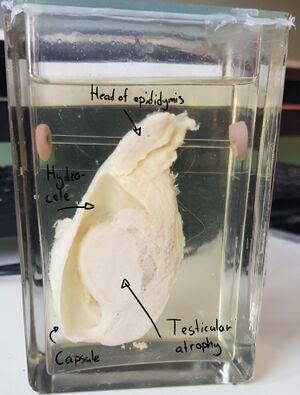45. Chronic epididymitis. Hydrokele. Atrophia of the testes.
Organ: Epididymis, testis
Description:
The testis is atrophied. There is fluid between the parietal and visceral layers of the tunica vaginalis, called hydrocele. The epididymis is inflamed, showing small greyish discolorations.
Diagnosis: Chronic epididymitis, testicular atrophy and hydrocele
Causes:
- Chronic epididymitis
- STDs
- Tuberculosis
- Sarcoidosis
- Testicular atrophy
- Atherosclerotic ischaemia
- Recurrent trauma
- Cirrhosis
- Anabolic steroid abuse
- Recurring inflammation
- Hydrocele
- Inflammation
- Heart failure
- Cirrhosis
- Trauma
- Torsion
Theory:
While small greyish discolorations are typically characteristic for chronic epididymitis these discolorations are not really visible on this preparation due to the formalin.

